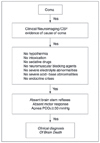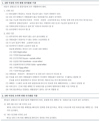Abstract
Brain death is a clinical diagnosis. The three cardinal findings in brain death are coma or unresponsiveness, absence of brainstem reflexes, and apnea. The clinical examination of the brainstem includes testing of brainstem reflexes, determination of the patient's ability to breath spontaneously, and evaluation of the motor response to pain. Spontaneous and reflex movements originating from the spinal cord neurons may occur in brain-dead patients. An awareness of spinal reflexes may prevent delays in and misinterpretations of the brain-death diagnosis. In some countries including Korea, our country, confirmatory tests are required by law when determining brain death. However, a confirmatory test is not usually mandatory except for patients in whom specific components of clinical testing cannot be evaluated reliably.
Figures and Tables
References
2. Wijdicks Eelco FM. Determining brain death in adults. Neurology. 1995. 45:1003–1011.
3. Morenski JD, Oro JJ, Tobias JD, Singh A. Determination of Death by Neurological Criteria. Journal of Intensive Care Medicine. 2003. 18:211–221.

5. Jorgensen EO. Spinal man after brain death. The unilateral extension-pronation reflex of the upper limbs as an indication of brain death. Acta Neurochir. 1973. 28:259–273.
6. Dosemeci M, Cengiz M, Yilmaz M, Ramazanglu A. Frequency of Spinal Reflex Movements on Brain-Dead Patients. Transplantation Proceedings. 2004. 36:17–19.
8. Ropper AH, Kennedy SK, Russell L. Apnea testing in the diagnosis of brain death: clinical and physiological observations. J Neurosurg. 1981. 55:942–946.




 PDF
PDF ePub
ePub Citation
Citation Print
Print





 XML Download
XML Download